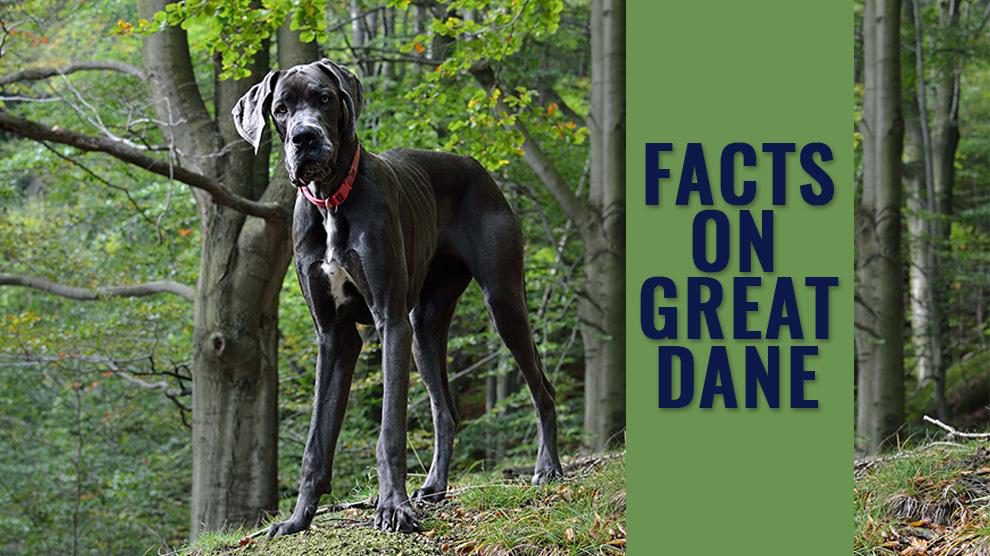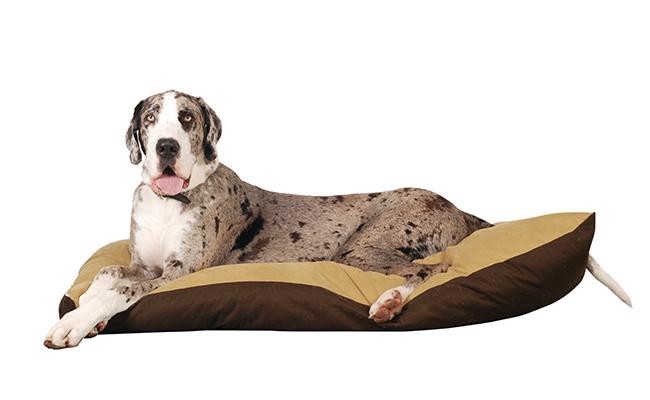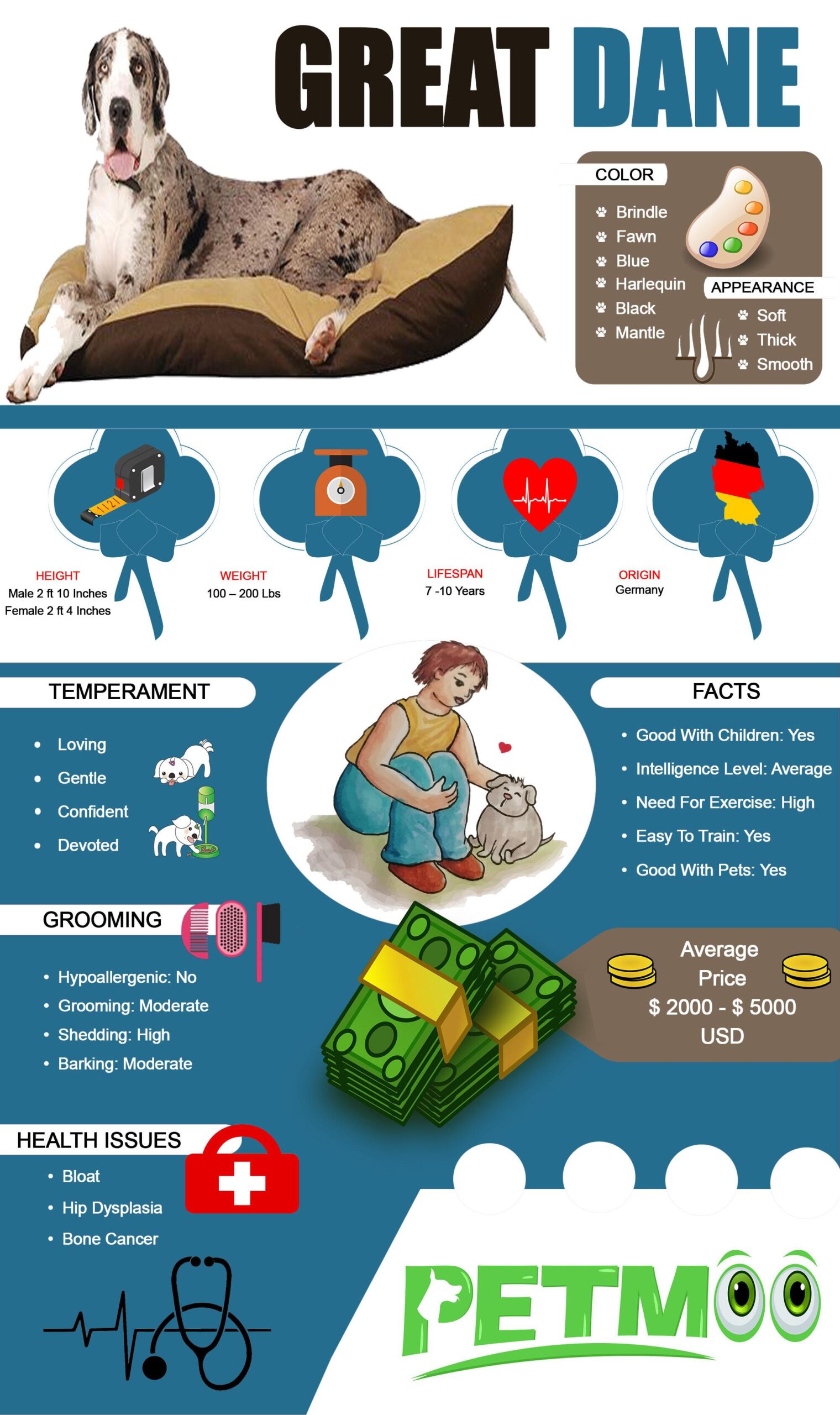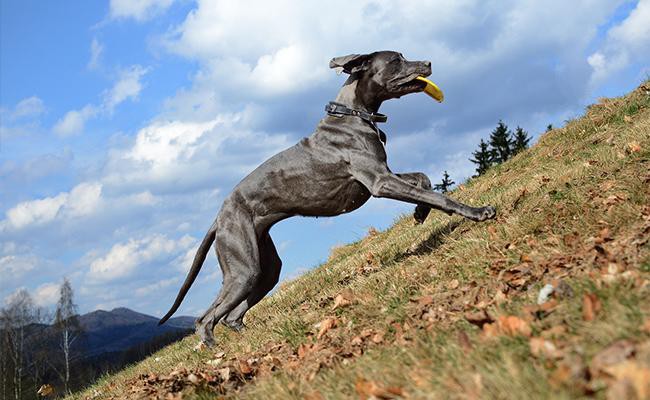Dog Pregnancy Calculator And Timeline
Whenever Danny rests his head on my lap, he reminds me of the good old days when we brought him home as a pup. He was 10 inches tall and weighed around 18 lbs then; my lap was his rest place and he would refuse to leave unless it is snack-time.
Now that he is all grown up and has a height equal to mine, he is more independent, courageous and friendly. Amidst his “busy” schedule, he never forgets to rest his head on my lap as if assuring me that he is still the little young Danny craving for attention and love.
Since you are here, you are either planning to buy a Great Dane or weighing the pros and cons of buying one. In either of the situations, this article will serve you as a perfect guide to choose the best.
Primarily the Great Dane was used to hunt down wild boars and protect large estate grounds but eventually, they turned out to be gentle giants and were mostly taken in as family dogs.
Great Dane Breed Characteristics Sheet
- Origin: Germany
- Size: Large (Apollo of Dogs)
- Dog Breed Group: Working Group
- Purebred: Yes
- Lifespan: 7 -10 Years
- Height (at Shoulder): Male- 2 ft 10 Inches, Female- 2 ft 4 Inches
- Weight: 100 – 200 Pounds
- Coat Appearance: Soft, Thick, Smooth
- Coat Colors: Brindle, Fawn, Blue, Harlequin, Black, Mantle
- Temperament: Loving, Gentle, Confident, Devoted
- Good With Children: Yes, Better Under Supervision
- Intelligence Level: Average
- Good With Pets: Yes
- Hypoallergenic: No
- Grooming: Moderate-High
- Shedding: High
- Barking: Moderate (High if they pick it up as a habit)
- Suitable For Apartments: High
- Need For Exercise: High
- Easy To Train: Yes
- Good For First Time Owners: Low, An Experienced Dog Owner Can Handle This Dog With Ease
- Health Issues: Bloat, Hip Dysplasia, Bone Cancer
- Litter Size: 8-10 Puppies
- Average Price: $ 600-$ 3000 Usd
Great Dane Size And Lifespan
Size
- Height – The Great Dane has a giant-like height that ranges between 2 feet, 4 inches and 2 feet, 10 inches at the shoulder.
- Weight – Their average weight could be between 100 and 200 pounds.
The height and weight may vary based on gender but the differences are very minute.
Lifespan
The average lifespan of a Great Dane is 7 to 10 years; few lucky and healthy one are known to have lived up to 12 years of age. On a general note, smaller dogs tend to live longer than giant dog breeds; it may seem unfair but it is a fact that bigger dogs age faster.
Great Dane Temperament
This breed is never aggressive as they may seem to be and their deep, grumpy growl and bark could scare off even the toughest of all burglars.
They may look ferocious but are gentle by nature, but strangers are bound to feel intimidated by their appearance.
This large and noble breed is sometimes affectionately referred to as the “Apollo of Dogs”; you would be surprised to know that Great Danes are very gentle with children.
Your child could be left alone and the dog would take care of your kid in every way possible, except for changing diapers of course!
A well-bred Dane is not just gentle, affectionate, playful and relaxed around children but they also exhibit a great deal of intelligence and are very good at learning new things.
Hence training sessions with a Great Dane are always fun-filled. Well, there are a few Great Dane owners who consider their Danes to be very stubborn learners.
Danes are usually friendly towards new visitors unless they sense the need to defend their masters; they exhibit a fierce attitude of protectiveness if they sense the slightest danger.
Great Dane Care
Great Danes have a hard time dealing with the winter season; they can’t bear cold weather. Ensure to keep your pet arm and make him wear a warm coat if needed.
Make it a habit for your Dane to have his teeth brushed at least thrice a week. Regular brushing is advisable if you want your pet to stay away from gum and bad breath issues.
Be very careful while you trim his nails, a slight scratch on his skin might scare him off the next time you try to cut his nails. Trimming nails at least once in 2 weeks is mandatory to avoid painful scratches on your pet’s body.
Get him used to regular vet visits and complete medical checkup is necessary to help your pet live healthier and longer.
Great Dane Food
FishgarGreat Danes should be fed well and their diet must be kept under check until they are four to five months. Since they grow rapidly, you must ensure that he is given at least 3 to 6 cups of food split into 3 meals during the early stages. Here’s a food chart for Great Danes based on their age;
3 Month to 6-Month-Old – 3 to 8 cups of food must be split into 3 portions a day.
8 Months to 1 Year – You can give them 10 cups of food a day but ensure that they aren’t overfed.
Adolescents – Female Danes could be given 8 cups and male Danes could be fed with a maximum of 15 cups a day.
Adult – 6 to 10 cups of dog food a day is enough for the dog at this stage. Ensure that they do not gulp down all the food at once; splitting up the food portions into 3 – 4 meals a day is advisable.
You should never feed some foods to your majestic Dane. Avocado, alcohol, hops, bread dough, salty and seasoned food items, moldy foods, garlic, onion, macadamia nuts, Scallions, etc.
Most favored food items for your Great Dane are chicken, fish, beef, lamb, or any meat proteins.
Great Dane Training
All dogs need to regularly exercise and at least 30 to 45 minutes walk around a park is necessary for a healthy long life.
Great Danes should be taken to busy parks while they are still young; this way they will learn to socialize better and make friends quite easily. Differentiating between friends and foes is another basic training that the breed would pick up with time.
If you have bought a Dane puppy, then you must avoid making it run until he is 18 months old. This is the time when their bones and joints are still forming; running at this juncture would only lead to serious injury to bones.
Start slow and as they grow, you will have trained them to a great extent. From obedience training to socializing, all of the training sessions must be slow yet consistent.
Great Dane Shedding And Grooming
The short, thick and smooth coat of a Great Dane sheds at a moderate range and is nothing less than a lot! Try brushing your pet’s hair with a soft bristle brush to help keep the hair and skin healthy.
Shedding may rapidly increase during the fall or spring; so stay ready to do a bit of cleaning during those months.
Try giving your Dane a bath, at least once weekly and obviously also when he gets dirty. Local pet stores always have branded shampoos for dogs; buy a gentle shampoo to avoid harming the texture of its coat.
Interesting Facts About Great Dane
- This breed was first used to hunt wild boars and guard estates.
- The favorite cartoon character “Scooby Doo” is a Great Dane.
- They are not statistically the tallest dog breed but as per the records, the tallest dog known in the world is a Great Dane named Zeus.
- They grow very fast when compared to other dog breeds.
- Great Danes are extremely sensitive and making them stay alone, away from the family, in kennels, can leave them feel anxious and depressed.
- They come in 6 different color shades – Brindle, Fawn, Blue, Harlequin, Black, and Mantle
Great Dane Health Problems
They are usually a very healthy breed but are vulnerable to genetic and bone disorders. Their huge body requires the Dane to grow at a rapid rate right from the day they are born.
Injuries and accidents at an early stage in a larger breed can lead to severe joint and bone issues that cannot be easily treated. Below listed are a few diseases that are common in a Great Dane;
Hip Dysplasia – Most of the dog breeds suffer from this genetic disorder. In order to avoid the occurrence of hip dysplasia in your puppy, you need to ask the breeder to give medical proof to declare its parents free from such a problem.
Bloat & Gastric Issues – Overeating and indigestion can sometimes lead to serious bloat issues. Unlike in humans, dogs find it difficult to breathe properly during bloat or gastric issues. In order to avoid this from happening, ensure to prevent your dog from playing soon after a large meal.
Ear Infections – This is another huge health issue common in all types of dog breeds. In order to prevent ear infections, you need to keep his ears clean and also ensure to clear the hair around its ears.
Bone Cancer – Cancer is another leading cause of death among Great Dane. Hence, ensure to take your pet for regular check-ups, in order to avoid complications at a later stage.
Great Dane Price And Breeders
Price
Great Dane could cost anywhere around $600 to $3000; some breeders may demand high for puppies that have clear medical test reports.
After purchase, the maintenance cost would also be much higher when compared to other smaller breeds; but it would be worth the effort and money spent.
Great Dane Breeders
Points to Remember When Choosing a Great Dane Breeder
Researching about the breeder completely before buying a Great Dane is mandatory. Make a list of breeders in your locality and meet each of them in person to learn about their love for pets and to analyze their genuineness. 2 Must-ask queries:
1. Was the parent breed healthy?
In order to avoid buying a pet that’s unhealthy and is prone to genetic disorders, enquire about its parents. Let the breeder know your desire to take a look at medical reports of its parents.
2. Are you a part of any local club for pets?
Great Dane breeders will definitely be a part of local clubs associated with pet welfare. Opt out from conversing further with a breeder who is not a part of any dog club.
Always demand to see medical reports and vaccination details; if refused, walk away from such breeders.






















